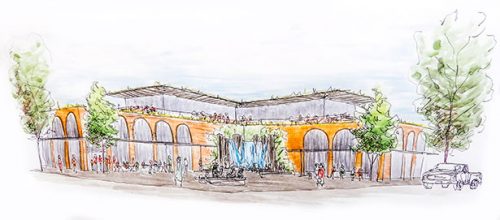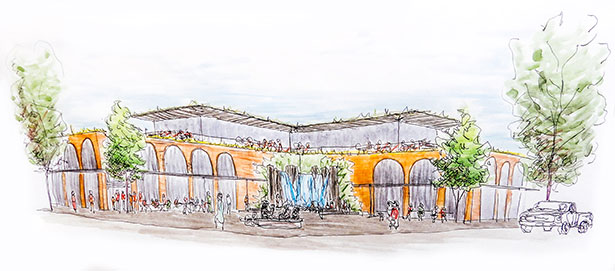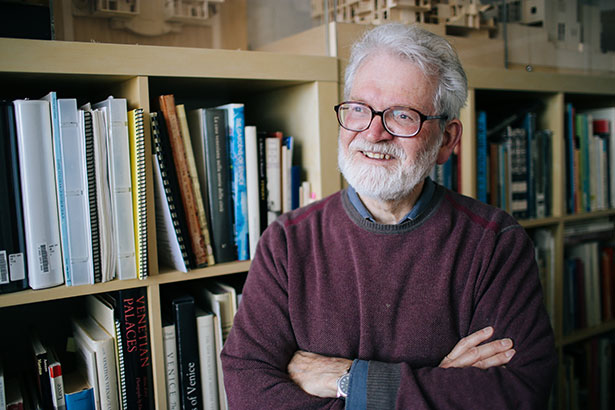
In ancient times, a traditional Roman town often had two major streets: the cardo and the decumanus. Where those two streets intersected, Romans built a forum or public space that marked the intersection as significant.
In Eugene, says UO professor of architecture James Tice, Willamette Street is the cardo, and Broadway is the decumanus.
“Whether people know it or not, the placement of Kesey Square is highly appropriate, and it’s an echo of that impulse to mark those two important streets,” Tice says.
As an urban designer with an eye on history, Tice has a unique perspective on a city’s open spaces.
“I like to think of a square like Kesey Square as a kind of living room for the city, an open forum, a place of public meeting or performance,” he says. “One doesn’t have to program a successful square. A successful square has a life of its own. It’s a part of the community — not a private affair, not one individual corporation owns it. It’s owned by the people of the city, free and open to everyone.”
 |
| Rendering of Kesey Square by UO architecture student Peter Obermeyer |
Kesey Square, a brick plaza smack in the middle of downtown, occupies an area of Eugene that’s witnessed an explosion of business and a growing sense of activity in the past few years. Despite this, the square has remained mostly static, known best for its handful of food carts, lack of seating and reputation for trouble.
Some call the square a hotspot of negative behavior, steering clear of it while walking downtown, and others call it their living room. Architects, city councilors, artists and activists all have different ideas for this space, from minor modifications to plopping a building on top of it.
At the University of Oregon, landscape architecture students are imagining how to transform Kesey Square into a positive, inclusive public space. Those with the power to implement change haven’t done much, but students have invented clever solutions to beautify the square, none of which involve covering it up with a building.
After years of inactivity, the time has come to do something about Kesey Square. Young minds and fresh ideas can breathe new life into the heart of Eugene.
Hearts and Squares
What is Kesey Square right now? Everyone has a different answer. Teesha Baldree says for her, it’s a refuge.
On a warm Wednesday afternoon in April, Baldree sits next to Ken Kesey’s statue on a marble bench. She gazes out on the bricks of Kesey Square — two food carts pushed against the side of a building, a single table and two chairs arranged in the middle of the empty square.
“It’s the only safe, secure spot to be, out in the open in front of everybody,” she says. “It’s like our living room.”
Baldree says when she moved to Eugene two years ago after having troubles with her friends and family, Kesey Square was the first place she spent the night. She’s currently homeless, she says, but she and her partner are trying to put together the money to rent a place.
Baldree says she’s heard rumors that the city of Eugene is trying to get rid of Kesey Square “because of the messes people leave behind.” She says at night, things can get messy — she’s watched people try to set fire to the flower pots in the square.
But, she says, “everybody knows what Kesey Square is. People from Maine and Florida know where it is. I’d be devastated if Kesey [Square] disappeared.”
Kesey Square didn’t start out as an open public space at all; in fact, a multi-story building with a drugstore once occupied its grounds. Formally known as Broadway Plaza, the square garnered its Kesey name in 2003, when artist Pete Helzer, a friend of the Kesey family, sculpted a bronze statue depicting author and Eugene icon Ken Kesey reading to his grandchildren.
A 2003 Oregon Art Beat episode shows the unveiling of the statue, with a crowded square and Kesey’s daughter, Sunshine, saying, “This is like having my living room in the middle of town. This is a special, special treat that makes my family much bigger.”
A Model Eugene
On an average spring afternoon, Kesey Square is quiet — young people sit next to Ken Kesey’s bronze statue, and a few food carts line one wall, while more people sit propped up against the other wall, their bags, dogs and bikes often scattered around them.
Come back later in the evening, during a First Friday ArtWalk or other city-planned event, and the square is bustling with activity and noise as people stream from one art site to the next.
And perhaps later that night, a rowdy mix of college students, bar hoppers and the unhoused intermingle with police officers roaming the streets of Broadway and Willamette.
The “layers of the day” is a concept that city of Eugene Public Art Manager Isaac Marquez encourages UO architecture students to think about when reimagining the square. At the students’ midterm in the UO architecture building, Marquez gives feedback: “Lighting, lighting, lighting,” he says. “It’s the key to public safety.”
Across the room, colorful architectural drawings and presentation boards reveal crisp lines and bright images of hypothetical Kesey Squares.
“I like to think of this as more of a model for what Eugene can be,” says Peter Obermeyer, an undergraduate in landscape architecture. His drawings show an open, people-filled pavilion with archways nestled into the background buildings and a waterfall tucked into the corner of the square. A rooftop terrace offers views for diners. The look emanates warmth and invitation.
Artist Betsy Wolfston, who designed the “Four Seasons” artwork near Kesey Square, gazes thoughtfully at the drawings. It’s her job to give Obermeyer feedback and advice on his midterm project.
“Twenty years ago, the city had the criteria not to put art along the building walls because they wanted to punch them out,” she says. “It’s funny to see things come full circle.”
Wolfston brings up ideas people have knocked around over the years — putting a building back in the square, for one — and Obermeyer nods.
“Part of the purpose of this studio is to prove that we shouldn’t have a building there,” he says. “It’s too valuable a space.”
Obermeyer and his fellow students, graduates and undergraduates alike, are intent on reimagining Kesey Square as an inclusive space. For now, students aren’t constrained by reality — it’s unclear, for example, if the buildings next to Kesey could support a second level — but it allows for greater creativity. The class, led by landscape architecture professor Ron Lovinger and local architect Joe Moore, generates ideas and fresh perspectives for the square.
“We believe that Kesey Square is essential to the structure of downtown Eugene,” Obermeyer says.
Moore says that, in many ways, he and Lovinger left the assignment open-ended. “We encouraged them to define the problem for themselves,” he explains. “Their solutions range from enhancement of the existing space to development of the full quarter block.”
For some, though, it’s hard to look past Kesey Square’s rough exterior.
Negative Space
John Rowell, an architect with Rowell Brokaw Architects and board member of Downtown Eugene, Inc., has looked at Kesey Square out the window of his office for the past 10 years. In that time, not much has changed, he says.
“As a square, I don’t see it as a super successful urban space,” he says. “It’s not obvious to people that it was the site of a nice building that was torn down for a pedestrian mall. The square is a remnant of that, and it never got re-envisioned. It’s paved nicely, but it doesn’t have a lot going for it — blank walls, odd shape. It’s not a shape you would design.”
Rowell says he thinks high-quality public space is important, a place where people of all economic backgrounds mix, but he questions the value of Kesey Square as Eugene’s primary public space. “I don’t think this one will ever cut it without some substantial rethinking,” he says. “I guess one question is, should we direct our energies elsewhere in downtown? We need to really be open to rethinking it, and I think everyone will be better off when we can get to that.”
Thomas Pettus-Czar, co-owner of The Barn Light, says he also recognizes the need for open space in downtown Eugene, but says he feels that Kesey Square is not a positive space as it currently operates. Located near the intersection of Willamette and Broadway, The Barn Light is right across the street from Kesey Square, and Pettus-Czar says it gives him a front-row perspective.
“I’ve seen everything under the sun take place there,” he says. “Everything from people defecating, people just littering and throwing trash, getting in fights, screaming at passersby, vandalizing — just a lot of stuff. It goes on and on.”
Pettus-Czar says this doesn’t happen every day, but more frequently in the warmer months, and sometimes staff at The Barn Light act as first responders to notify White Bird Clinic’s emergency response team (CAHOOTS) or the police.
“It can distract our employees from doing what they’re supposed to do because we’re helping customers deal with a problematic situation across the street,” he says.
Downtown Living
Sue Sierralupe, clinic manager of Occupy Medical, says from her time spent in Kesey Square, at least in the evenings, drunk college students, not the unhoused, are causing most of the obnoxious behavior and hassling. She says drug activity can be a problem in the square, adding that meth dealers pass through Eugene in the fall, heading to Kesey Square and providing to students and the unhoused.
“That is an unpleasant part of downtown living, and I’m not going to pretend that doesn’t exist,” she says.
But, she adds, continual police and security officer intervention can make life more stressful for people spending time in Kesey Square.
“The very people that are targeted by the police and by other citizens — they’re the young kids that are targeted with the crappy drugs,” she says. “Those are the kids that are victims of the sex trafficking, victims of the heroin deals, the violence. They’re seen by downtown business communities as the problem, but there’s no restitution for the injustice that’s played on their bodies.”
 |
| ‘I think of Kesey Square and its location as being really crucial,’ UO Architecture professor James Tice says |
Sierralupe, along with others in the Occupy Eugene movement, started a gathering in 2012 called Kesey Square Revival. The point, Sierralupe says, was to bring more than food carts and customers to the square. “We wanted it to be somewhere people could safely gather and play chess like in other cities,” she says.
Sierralupe and local activists Jean Stacey and Alley Valkyrie encouraged people to bring tables and chairs into the square, gathering every Friday during the summer. She says in many ways, the movement was successful, with groups of people playing board games in the evenings, but an aggressive food cart owner made interactions in the square difficult, and in 2013, the group disbanded.
“Just in general there’s this concept that this is our own, this is our downtown, and this space is in the heart of Eugene,” Sierralupe says. “And yet, you can’t be down there unless you’re physically in a store or purchasing things.”
Squaring Off
For traveling musicians like Harrison Blackey, a lack of downtown space to play guitar and violin is a problem. He says that after spending three days in Eugene, he noticed the lively street life contrasted with the heavy presence of security officers moving people in the downtown area.
“I heard the city’s trying to shut down the square,” Blackey says. “Out of sight, out of mind. It’s a shame, because one of the most interesting parts of a city is its street life.”
Blackey says he ended up spending time in Kesey Square because security officers kept telling him to go elsewhere. He says when he asked where he could go, the guides told him to go to Kesey Square.
The square is the only open public space in Eugene that doesn’t have a curfew. In May of last year, the Eugene Police Department brought a proposal to the City Council suggesting that the square close between the hours of 11 pm and 6 am. The Eugene City Council did not act on the proposal.
People in the square often sit on the ground, leaning up against buildings because, with the exception of the bench where the Kesey statue sits, all permanent seating has been removed.
Nan Laurence, senior planner for the city of Eugene, says the city has surveyed the locations of benches downtown and found that “we have seating all over downtown, but it’s not necessarily in the right spot.”
Eugene City Councilor Betty Taylor says she’d like to see the seating returned.
“I was really disappointed when they took out the seating. It’s ridiculous,” Taylor says. “What they want to do is chase away people that other people don’t want to see. We need places to sit. There should be real benches and real seating.”
Taylor says her main concern is that the square remains open and public. “Don’t destroy the space,” she says. “If they put a building there, which some people want to do, it would destroy one of the last open spaces in the city.”
Sense Of Place
UO’s architecture students are figuring out ways to preserve Kesey Square as an open space. Joe Moore of GMA Architects says he’s attended stakeholder discussions on Kesey Square for the past few years, and that’s what prompted him to collaborate with UO professor Ron Lovinger to create a studio that generates ideas for the space.
“I think, despite its shortcomings, it’s a really unique space in Eugene,” Moore says. “The current perception of the space is perhaps a little too shortsighted. It seems like the conversation was moving toward the reasons why it isn’t successful now, and that was a rationale for getting rid of it, rather than figuring out a way to make it more inclusive.”
Pettus-Czar of The Barn Light, a stakeholder who gave feedback to the architecture students at their midterm, says regardless of which avenue of change is decided, it’s important that the spot be recognized as a landmark.
He says the studio is “exactly what I want to see in those kinds of conversations taking place, where you’re involving the community to identify the problems and propose different solutions.”
At the studio midterm, landscape architecture grad student Colin Poranski proposed fountains spraying water from the ground for kids to run through in the summer, and undergraduate Scott Carey, who says he wanted to tell the story of Kesey through his redesign, featured lots of greenspace and glass to make the space brighter and more natural.
“That should be a goal in revitalizing downtown — giving Eugene a sense of place,” he says.
Bryn Davis, a first year graduate student in landscape architecture, envisioned Kesey Square surrounded by ponderosa pines, creating a forest grove in the middle of town. “I wanted it to have the feel of a sanctuary,” she says.
Laurence with the city of Eugene, who also gave feedback to the students, says she thinks of the studio primarily as an educational opportunity: “I’m not looking at it as getting solutions that we’re immediately going to implement. I’m looking at it as, ‘Why wouldn’t we take this opportunity to take advantage of new ideas that may come before us?’”
She says she doesn’t speak for the entire city, but she feels there are “a number of ways to get it right.”
One thing is clear: The Eugene community cares about the fate of Kesey Square. Creative minds at the UO seem particularly well suited to revamp the space, if those in power will listen.
Sometime in June, Moore says, the landscape architecture students will finish their designs and have their final exam, an event which — as befits an exercise in fixing a public space — is open for all to attend.
EW will post the date and location when information becomes available.